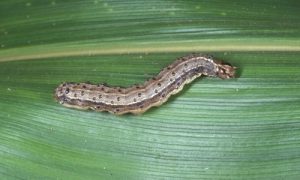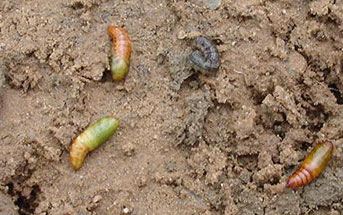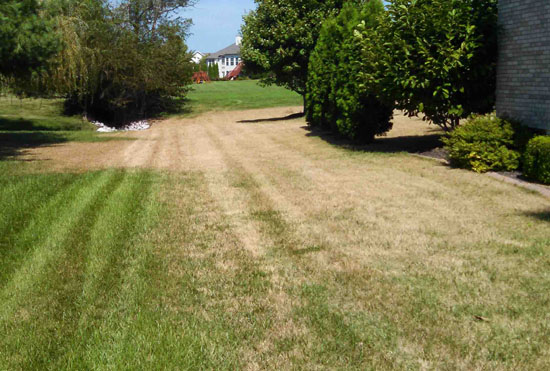Fall Armyworms Marching Into Town
By Pat Dickey, Fairfax Master Gardener

Mature Larvae
Late in August, the University of Maryland Extension, located within our Zone 7, began to receive reports of armyworms damaging turfgrass in residential areas. The damage mostly occurred in areas where the turf was recently seeded during this past summer. Fall armyworms can become a sporadic yet serious pest of many turfgrasses, including fescue, ryegrass, bluegrass and bermudagrass.
The worms are the larval stage of the fall armyworm moth (Spodoptera frugiperda) from the Lepidoptera family. They feed on leaves and stems of cultivated grasses and more than 100 plant species. Unlike grubs, fall armyworms feed above ground level, and the damage results in a visible browning of the area.

Armyworm Pupae
Fall armyworms are native to the tropical regions of the Western Hemisphere, from the United States to Argentina. They have been found in all states east of the Rocky Mountains. Their larvae are 1 to 1 ½ inches long and vary in color from green to mottled brown to black, depending on the instar (generation). A way to easily identify them is by the wide black stripes running down each side of the body. They have four pairs of prolegs attached to their abdomen.
They overwinter in the pupae stage then migrate northward in the spring and through the summer. Female armyworm moths lay 100 to 200 eggs per mass and average 1500 to 2000 in a single layer. To identify them, the adult moths have white underwings, and the mottled forewings have a triangular white spot near the tip and another spot in the center of each wing. Their eggs are laid near turfgrass on neighboring surfaces, such as bleachers, light posts and fences. After the eggs hatch, the new larvae may spin silken threads to lower to the turf to feed. The earlier instars eat a small amount of leaf material, while the later stages eat 93 percent of their total life span of food. Early damage is often overlooked because of this, and major defoliation can occur in a short time.

Adult Male Armyworm
Damaged areas will start around where egg masses are laid and radiate outward. The armyworms cross the turfgrass as a group and create a line between the damaged and undamaged turfgrass. The larvae feed both day and night and are highly mobile. They were named “army” because of the speed in which they can move across large agricultural fields in two or three days.
Newly seeded lawns or those with newly installed sod are most susceptible to fall armyworm damage. Areas with Bermudagrass usually recover due to its aggressive rhizomatous and stoloniferous growth. However, areas with newly established bunch-type grasses, such as fescue and ryegrass, may be stunted or killed by the armyworm feeding.

Lawn damage
Several types of treatment are recommended by Virginia Cooperative Extension, including Azadirachtin (neem oil), Bifenthrin (a pyrethroid) and Spinosad. Be sure to read the directions before applying these products and wear protective goggles and gloves. Do not mow for several days after treatment. Apply the treatment to small larvae since controls tend to be ineffective on larger larvae. They tend to feed then soon burrow into the soil. Apply controls in early evening. Watering is not necessary after applying them. Treated areas may become quickly reinfested from surrounding areas because of the high mobility of the fall armyworms.
VCE recommends the use a drench test to determine whether or not controls of these armyworms are needed. Mix three to four tablespoons of dishwashing liquid into two gallons of water. Pour evenly over 1 square yard of turf. Watch the area for 10 minutes, counting caterpillars as they rise to the surface. Treatment is required if there are more than nine caterpillars per square yard.
Resources
• Armyworms in Turf, Integrated Pest Management Report, University of Maryland Extension,
August 27, 202l, p. 6
• Armyworms, Alejandro Del-Pozo and Curt Lamb, Lawn Insects, 5-3 to 5-5, 2021 Pest Management
Guide, 456-018, Virginia Cooperative Extension
• Fall Armyworms in Turf, Terri Billeisen and Rick Brandenburg, North Carolina State Extension
• Fall Armyworm, John L. Capinera, Entomology and Nematology, University of Florida and Florida
Department of Agriculture and Consumer Services
• Armyworm, Casey Reynolds, Mike Merchant, and Diane Silcox Reynolds, Aggie Turf, Texas
A&M University